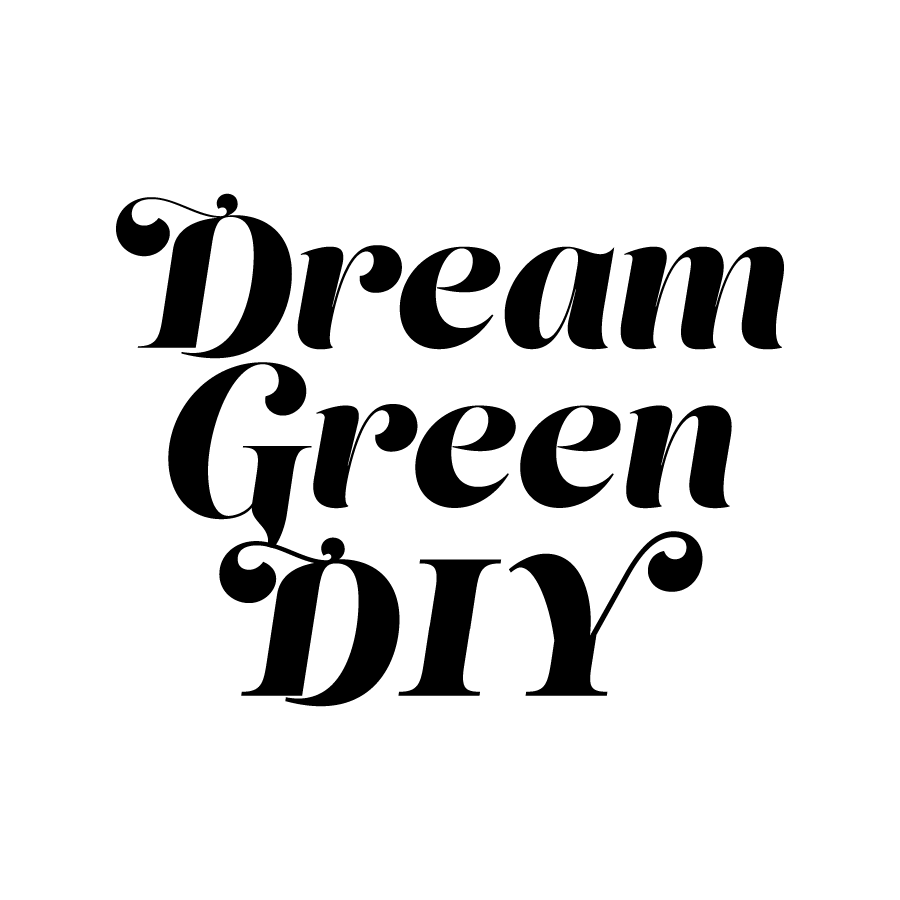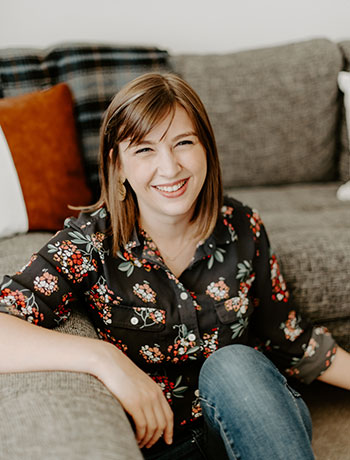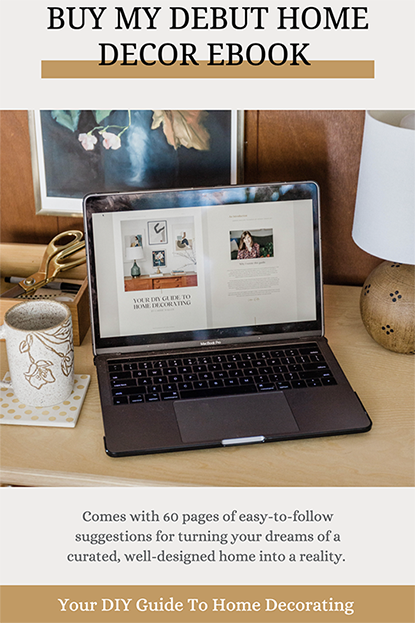.jpg)
In case you’re new around here and didn’t know, I’m a working ceramicist in addition to my full-time gig as a lifestyle and design blogger. I started my pottery journey back in 2018 when I signed up for a class on a whim at Make Waynesboro Clay Studio here in town. Since then, I’ve been hard at work developing my own style of ceramics and researching the work of other talented artists so I can soak up everything there is to know about making good pottery. I chose the name DGD Pottery to act as a facet of my Dream Green DIY brand, and opened my own ceramics shop on Etsy, which you can check out here. My portfolio site for DGD Pottery is this way in case you want to see more of my past work.
But I digress…The point of today’s post is to share the latest major milestone for my pottery business: my home pottery studio. This DIYed space has been in the works for about two or three weeks now, and I’ve been scrambling behind the scenes to make it photo-worthy so I could share the room with you here on the blog. I absolutely devoured home pottery studio tours online before starting to invest in my own space, and I wanted to create my own content following that theme in case you’re starting the process yourself. Keep scrolling for a look at our unfinished basement before, then after, plus my list of “must-have” home pottery studio equipment (adding quotes there since you, of course, should take my personal must-haves with a grain of salt). Let’s get to it.
.jpg)
.jpg)
.jpg)
Those photos show what our basement looked like before John and I moved in. The space is enormous, following the footprint of almost the entire main floor of our brick ranch home. With so many planned projects upstairs in terms of décor when we first moved in in 2022, I never really thought much about the basement other than to be grateful for the size of it knowing that we could make good use of it for storage. Aside from the main square-shaped area that you see pictured in that second photo above, the basement also includes a long hallway of sorts that leads to our boiler and hot water heater tucked around the back corner out of sight, and a walled-off flex space (you can see the walls of it in the photo above) that John is using as his home gym.
.jpg)
.jpg)
.jpg)
.jpg)
Those photos above show how we’ve been living with the basement for the past two and a half years. Its main function up until this point had been for storage. I lined three of the four walls with rolling shelves that we still use for things like holiday décor, out-of-season clothes (the clothing closet in our bedroom upstairs is tiny), seasonal accessories, extra art, bulk paper products, memorabilia, tools, etc.
That stuff you see in the center of the room was the very beginnings of my home pottery studio. I had pulled an old work bench left behind by the previous homeowners into the middle of the space and set that up as my shipping station for pottery sales on Etsy with loose packing materials, art postcards, tape, and “Fragile” stickers. It was organized even if it didn’t look good.
Around the time that I reopened my Etsy shop, though, my dad started trying to convince me that I needed to take things all the way by getting a wheel and turning the entire room into a working home pottery studio. Ultimately, I realized that he had the right idea, so he and I made the trip to Clayworks in Richmond where we picked up my new Shimpo wheel. After that, I hit the ground running to make the basement a fully functioning (and decorated!) pottery studio fit for the DGD brand.
.jpg)
.jpg)
.jpg)
.jpg)
.jpg)
.jpg)
.jpg)
.jpg)
My mom, John, and I spent days painting the dingy stained cinderblock walls bright white, I painted one feature wall a pretty blue color, and I hung every single one of the pieces of art that I had in storage on the wall. This gallery wall serves two functions: (1) it got all of my extra art off the storage shelves and up onto the wall to create more room in the storage area of the basement, which I moved to that hallway part of the space that I mentioned before, and (2) it creates a really graphic, inspiring focal point for my pottery/art studio.
After the walls were painted, I worked on scrubbing down the old utility sink and door while my dad spent a couple of days installing new overhead lighting for me. He put in a dedicated breaker so that the new lights operate on their own switch, and I found a handy screw-in light bulb that has a built-in fan to put above my wheel since it can get sort of stuffy in our basement this time of year.
If you’d like to know about all of the other equipment and resources for items in my pottery studio, keep scrolling for an exhaustive list. Again, I’m calling it a “must-have” list, but know that you might not need all of the things I chose to include, or you might have your own must-haves that I don’t personally find necessary at this time. This is all specific just to throwing, too, since I don’t have a kiln for firing.
.jpg)
.jpg)
.jpg)
.jpg)
Home Pottery Studio “Must-Have” Equipment:
- Pottery wheel (I went with the Shimpo VL Whisper since it’s what I learned on at our community pottery studio)
- Stool for your wheel
- Wedging table (I screwed a concrete backer board meant for a shower stall on top of an old work table that I had from IKEA, which is, sadly, no longer available)
- Metal work table
- Large metal shelves on wheels
- Spray bottle
- Large 5-gallon lidded buckets (for reclaim, rinse water, glazes, etc.)
- Bucket dollies
- Ware boards (I bought a sheet of MDF and cut it into a variety of sizes to use for my greenware pieces)
- Bat system
- Sponges
- Calipers
- Rolling pin
- Banding wheel
- Paddle attachment for a drill to mix up reclaim and glazes
- Towels
- Throwing gauge
- Mirror
- Respirator
- Mop and bucket
- Dry cleaning plastic for covering wet greenware
- Plaster boards for reclaim and drying out clay
- Two duct tape-wrapped wall board squares for flattening clay tiles
- Long overhead light fixtures
- Screw-in light/fan fixture
- BONUS: Cork/dry erase board for notes, calendar to plan out commissions and events, rice paper lamp and light kit, faux floor plant, faux hanging plant, rolling cart for tool storage, baskets for tucking plastic away, plastic totes in a variety of sizes for clay and tool storage, short tables to keep near your wheel for holding freshly thrown pieces, a small wipeable side chair, easy-care rug for a pop of color and somewhere soft to rest your feet between work, DIY art book display shelf
.jpg)
.jpg)
.jpg)
.jpg)
As I said, that list doesn’t include all of the necessary equipment that you’d need if you also plan to have a kiln in your studio since I’m still firing all of my work at our community studio, but if you need a kiln, I’d also add things like squeegees, tongs, pouring cups, large bowls, wax, lidded containers, and all of the glaze ingredients for your preferred style. I’ll plan to share an updated blog post whenever I manage to add a kiln to my space since I know that’s a pretty tricky addition to any home pottery studio. There’s a lot that goes into glazing, and I’m excited to think about the possibilities for my own home glazing lab someday. In the meantime, though, I’m grateful to have our community studio where I can continue to experiment and get help from the super talented potters I work with.
.jpg)
.jpg)
.jpg)
.jpg)
.jpg)
.jpg)
.jpg)
Before I wrap things up, I just had to share a few before/after shots of the space. Everything we did was purely cosmetic in the space. We painted walls, installed new lighting, and added a few decorative touches, like greenery, art, and modern furniture. The power of paint alone never ceases to amaze me. As soon as I stepped back to take in the new fresh white walls and my own minty blue/green gallery wall, I felt like I was in a completely different room. It’s still an unfinished basement, but the thoughtful touches and upgrades we made really gave this space a finished feeling that I know I’ll be extra creative in.
The blue paint, by the way, is a mixture of all the open blue paints I already had on our painting shelf, so I can’t tell you the exact color, but it’s similar to “Hazel” from Sherwin-Williams. The white walls were done using a mixture of, again, all the white paint and primer that we already had on our paint shelf, and then this white primer to finish things off when we ran out of open cans of paint. We used about 10 gallons of paint to cover the 600-square-foot room. Oh, but the added bonus of using that primer I linked to is that it came in really nice buckets with metal handles. If you’re a working potter, then you know just how handy a lidded bucket can be, so those will be put to good use in my studio now that the painting is done.
.jpg)
.jpg)
.jpg)
.jpg)
Let me know in the comments of today’s blog post if you have any questions about my brand new setup or if you have some suggestions to make about my space. I’ve done a little bit of throwing in the studio since getting the wheel a few weeks ago, but the bulk of my time lately has been spent revamping the décor of the room itself so that I have a clean, functional space that feels inspiring rather than stressful to work in. Now that it’s finally done, I’m over-the-moon excited to get to work on my next collection of ceramics. Keep an eye on the DGD Pottery Etsy store to see what’s coming down the pipeline this fall.
.jpg)
.jpg) *This post contains affiliate links, which means that I earn a small commission when you purchase products that I recommend at no additional cost to you. This allows me to provide free creative content for you to read, save, and share. Rest assured that I never recommend products we wouldn’t use or don’t already love ourselves.
*This post contains affiliate links, which means that I earn a small commission when you purchase products that I recommend at no additional cost to you. This allows me to provide free creative content for you to read, save, and share. Rest assured that I never recommend products we wouldn’t use or don’t already love ourselves.





Wow—great creative space!
Thank you!